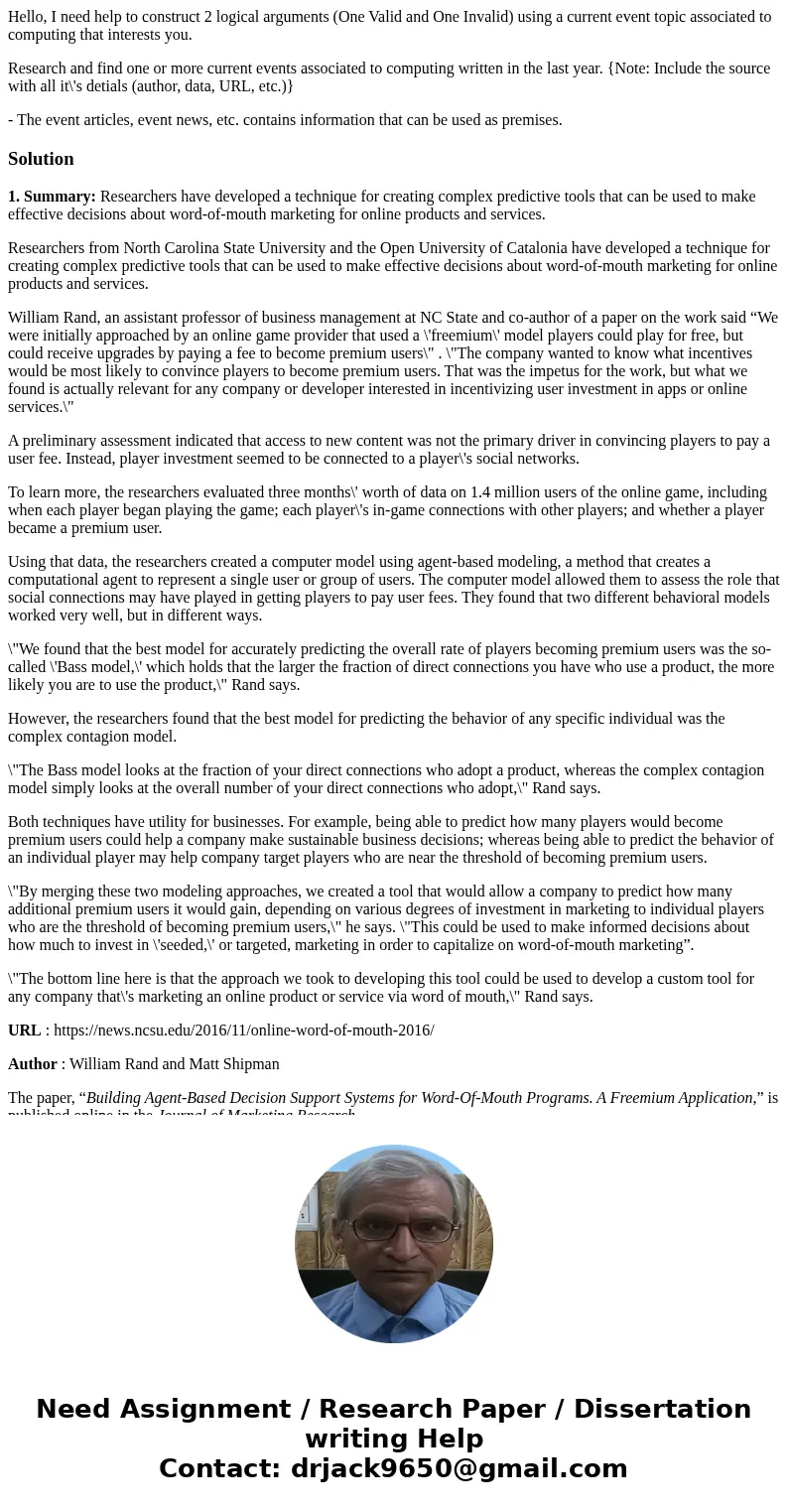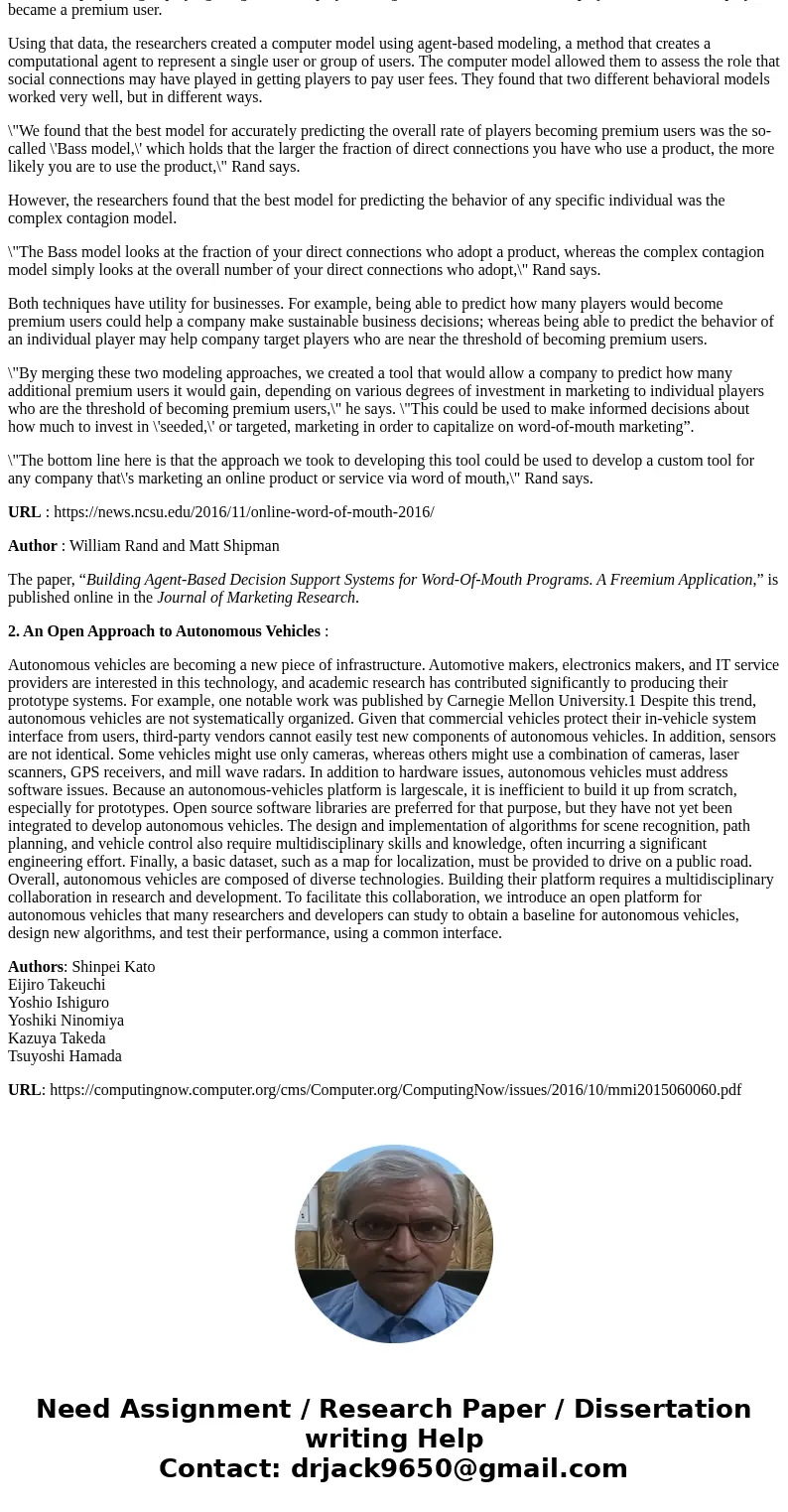Hello I need help to construct 2 logical arguments One Valid
Hello, I need help to construct 2 logical arguments (One Valid and One Invalid) using a current event topic associated to computing that interests you.
Research and find one or more current events associated to computing written in the last year. {Note: Include the source with all it\'s detials (author, data, URL, etc.)}
- The event articles, event news, etc. contains information that can be used as premises.
Solution
1. Summary: Researchers have developed a technique for creating complex predictive tools that can be used to make effective decisions about word-of-mouth marketing for online products and services.
Researchers from North Carolina State University and the Open University of Catalonia have developed a technique for creating complex predictive tools that can be used to make effective decisions about word-of-mouth marketing for online products and services.
William Rand, an assistant professor of business management at NC State and co-author of a paper on the work said “We were initially approached by an online game provider that used a \'freemium\' model players could play for free, but could receive upgrades by paying a fee to become premium users\" . \"The company wanted to know what incentives would be most likely to convince players to become premium users. That was the impetus for the work, but what we found is actually relevant for any company or developer interested in incentivizing user investment in apps or online services.\"
A preliminary assessment indicated that access to new content was not the primary driver in convincing players to pay a user fee. Instead, player investment seemed to be connected to a player\'s social networks.
To learn more, the researchers evaluated three months\' worth of data on 1.4 million users of the online game, including when each player began playing the game; each player\'s in-game connections with other players; and whether a player became a premium user.
Using that data, the researchers created a computer model using agent-based modeling, a method that creates a computational agent to represent a single user or group of users. The computer model allowed them to assess the role that social connections may have played in getting players to pay user fees. They found that two different behavioral models worked very well, but in different ways.
\"We found that the best model for accurately predicting the overall rate of players becoming premium users was the so-called \'Bass model,\' which holds that the larger the fraction of direct connections you have who use a product, the more likely you are to use the product,\" Rand says.
However, the researchers found that the best model for predicting the behavior of any specific individual was the complex contagion model.
\"The Bass model looks at the fraction of your direct connections who adopt a product, whereas the complex contagion model simply looks at the overall number of your direct connections who adopt,\" Rand says.
Both techniques have utility for businesses. For example, being able to predict how many players would become premium users could help a company make sustainable business decisions; whereas being able to predict the behavior of an individual player may help company target players who are near the threshold of becoming premium users.
\"By merging these two modeling approaches, we created a tool that would allow a company to predict how many additional premium users it would gain, depending on various degrees of investment in marketing to individual players who are the threshold of becoming premium users,\" he says. \"This could be used to make informed decisions about how much to invest in \'seeded,\' or targeted, marketing in order to capitalize on word-of-mouth marketing”.
\"The bottom line here is that the approach we took to developing this tool could be used to develop a custom tool for any company that\'s marketing an online product or service via word of mouth,\" Rand says.
URL : https://news.ncsu.edu/2016/11/online-word-of-mouth-2016/
Author : William Rand and Matt Shipman
The paper, “Building Agent-Based Decision Support Systems for Word-Of-Mouth Programs. A Freemium Application,” is published online in the Journal of Marketing Research.
2. An Open Approach to Autonomous Vehicles :
Autonomous vehicles are becoming a new piece of infrastructure. Automotive makers, electronics makers, and IT service providers are interested in this technology, and academic research has contributed significantly to producing their prototype systems. For example, one notable work was published by Carnegie Mellon University.1 Despite this trend, autonomous vehicles are not systematically organized. Given that commercial vehicles protect their in-vehicle system interface from users, third-party vendors cannot easily test new components of autonomous vehicles. In addition, sensors are not identical. Some vehicles might use only cameras, whereas others might use a combination of cameras, laser scanners, GPS receivers, and mill wave radars. In addition to hardware issues, autonomous vehicles must address software issues. Because an autonomous-vehicles platform is largescale, it is inefficient to build it up from scratch, especially for prototypes. Open source software libraries are preferred for that purpose, but they have not yet been integrated to develop autonomous vehicles. The design and implementation of algorithms for scene recognition, path planning, and vehicle control also require multidisciplinary skills and knowledge, often incurring a significant engineering effort. Finally, a basic dataset, such as a map for localization, must be provided to drive on a public road. Overall, autonomous vehicles are composed of diverse technologies. Building their platform requires a multidisciplinary collaboration in research and development. To facilitate this collaboration, we introduce an open platform for autonomous vehicles that many researchers and developers can study to obtain a baseline for autonomous vehicles, design new algorithms, and test their performance, using a common interface.
Authors: Shinpei Kato
Eijiro Takeuchi
Yoshio Ishiguro
Yoshiki Ninomiya
Kazuya Takeda
Tsuyoshi Hamada
URL: https://computingnow.computer.org/cms/Computer.org/ComputingNow/issues/2016/10/mmi2015060060.pdf


 Homework Sourse
Homework Sourse